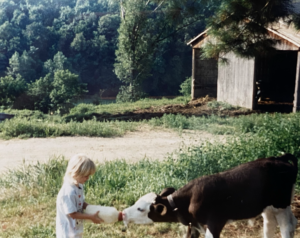By TEAGAN MERRIMAN – In June of 2019, graphic video footage of workers at Fair Oaks Farms – one of the country’s largest dairy operations – punching cows, beating them with metal poles, and even breaking their tails flooded the internet.
Rightfully so, Americans were outraged at the thought of the animals responsible for the production of their produce were being out rightly abused. However, many fail to realize that the solution starts at home with the support of local farmers and not the immediate jump to eating vegan and plant-based foods.
The sooner consumers become informed that much of the animal mistreatment seen in the produce industry, one of society’s main objections to the consumption of things such as dairy and poultry products, can be reduced, the sooner local farmers will see benefits. Growing up on a small dairy farm owned and operated by my grandparents, and the most cows owned by my family at any given time never exceeded 40, and for those who are concerned about the mistreatment and abuse of farm animals, that’s something to make note of.
Large industrialized farms simply can’t competently care for animals.
As reported by the National Milk Producers Federation, about 94% of dairy farms own fewer than 500 cows. Those numbers, unfortunately, are on the decline as many small, family operated dairy farms are being forced to shut down, all thanks to the rise of commercial farming.
The USDA (United States Department of Agriculture) claims that 97% of America’s farms (including but not limited to dairy farms) are family owned and operated, and sure, that’s great, or at least that’s what the USDA wants you to think. Perhaps not so shockingly, the small 3% of corporately operated farms accounts for 44% of the value of farming production.
So, why should we care that the small number of corporate farms hold such a large stake of American produce? Simply because local farmers are suffering at the hands of large corporate figures who know nothing of agriculture, such as Bill Gates, who owns 242,000 acres of farmland in the United States.
I’ve seen first-hand the detrimental effects industrialized farming has had on local farmers. My grandparents made the decision, after years and years of farming, to close – simply because the hard work was not worth the profit.
Well, how is the profit minimal? The National Farmers Union notes that farmers and ranchers receive only 14.6 cents of every food dollar that consumers spend – a microscopic amount of money in comparison to the gigantic amount of money it costs to own and operate a farm, which, by the way, is left to farmers to bear the brunt of while corporations steal nearly the entirety of the profits. Also, according to the National Farmers Union, for a 1 pound package of bacon priced at $5.00, the farmer will only see 63 cents.
My grandfather stated, “Large farms have thousands of cows while small farms only have 30-40 cows. Most farms operate on a profit margin, so (assuming you would make a dollar per cow per day) a farm with 1,000 cows would make $1,000 a day whereas a farm with 30 cows would make $30 a day, all while the same amount of investment goes into both. The cost outweighs the profits, and large farms are the only ones that can survive.”
Not only are those living in Indiana who work in agriculture suffering, so is your food. By skipping out on the local food, you’re also skipping out on freshness, flavor, and nutrients.
My grandmother mentioned, “If you buy local produce from a local food market, it’s much fresher than anything that has been shipped in from California or anywhere else.”
The less time food has between the farm and your table, naturally, the fresher it will be. They will not have been sitting in distribution centers, slowly losing nutrients and their intensely delicious flavors.
Senior Taylor Sheesley noted, “I think students should shop for produce locally because local farms are part of our community and it’s good to support each other and keep our community together. With the pandemic going on, it’s good to support local farms that had their income slow down in 2020. Local farms definitely have better milk and better produce.”
Be a patriot and buy local.

[Photo courtesy of Teagan Merriman]
Photo Caption: “An old photo from my grandparent’s family farm.”


